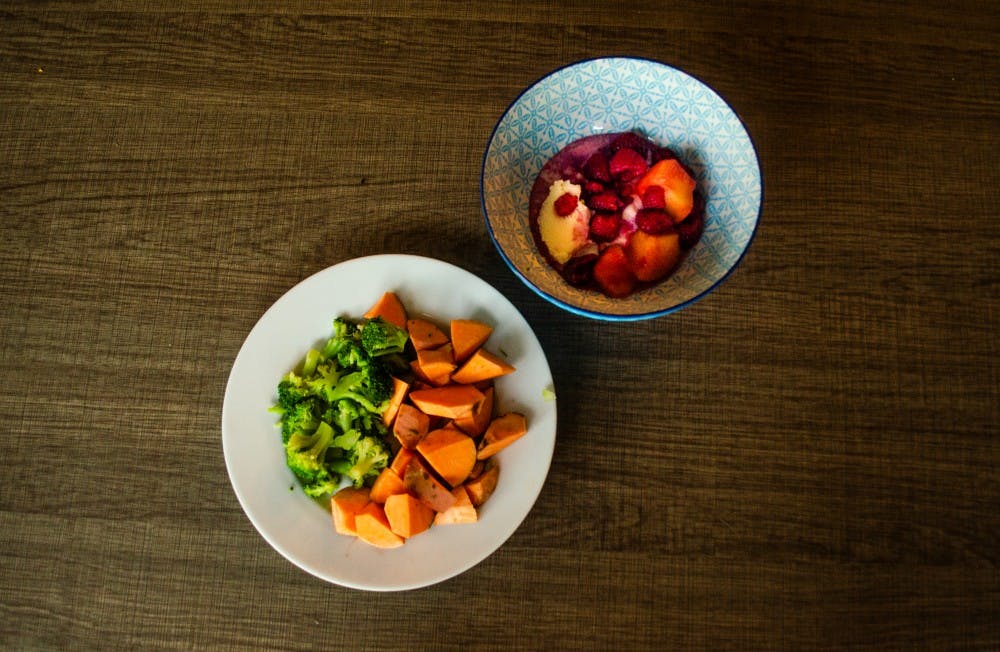Is the dishwasher the final frontier of cooking? Search “dishwasher dinner” online and you’ll find a slew of blogs and articles with recipes you can cook while simultaneously washing the gunk off your cereal bowls. Even Oprah offers up a recipe for lunch cooked in the dishwasher—salmon and asparagus over noodles. As a self–described foodie and avid cook, I had to discover this for myself. Clean dishes and efficient meal prep? Count me in.
After scouring the internet for recipes (many of which lacked “after” photos or precise guidelines), I learned the best approach is to slow poach food in airtight jars. Dishwashers run between 120 F and 150 F and one cycle lasts at least 2 hours, the equivalent of slowly steaming food at low heat. This method suits veggies, fruits, and even salmon, but nothing that needs high heat—so steak is out of the question. Airtight jars are essential to prevent soap contamination, so before I began cooking my three course meal, I armed myself with three mason jars, an arsenal of groceries, and one dishwasher.
Round 1
Jar 1: 3 frozen dumplings from Trader Joe’s. (Normally I would steam these, so maybe the dishwasher would do the same?)
Jar 2: 1 raw egg and 1/4 cup of water. Numerous blogs promised dishwasher eggs should come out almost hard–boiled, with jammy but not quite solid yolks.
Jar 3: Handful of potato gnocchi and ¼ cup tomato sauce. (You can’t screw up gnocchi, right?)
Dishwasher brimming with dirty plates, bowls, and silverware, I furtively tucked in the three mason jars, all tightly sealed and filled to the brim with food, hoping my roommates wouldn’t notice. I ran the dishwasher just shy of 11 p.m., anxiously awaiting my midnight snack.
Results:
2.5 hours later, I opened the steaming dishwasher. I carefully pried open each mason jar and inspected the contents. The dumplings turned out a little worse for wear, somehow both leathery and soggy, falling apart at the seams. I tried spearing one and the contents spilled out into the jar, leaving me to contend with a mess of shredded carrots and diced mushrooms. Meanwhile, the gnocchi were chewy in the center, a notch above al–dente and swimming in lukewarm tomato sauce—definitely edible, but not at all pleasant. The eggs were the biggest disappointment. I tried peeling one and it exploded on the kitchen counter into a mess of liquid yolk and semi solid whites. Even as a fan of runny yolk, just looking at the egg gave me salmonella chills.
Round 2
Determined not to give up, I decided to give the dishwasher another shot. Articles online recommended cooking potatoes and veggies. I filled one jar with frozen broccoli florets, cubed sweet potatoes, and a sprinkle of salt and pepper. No meal is complete without dessert, so to the second jar, I added frozen mango chunks, frozen raspberries, and a generous dollop of honey; a fruit parfait of sorts.
Results:
Jar 1: Surprisingly, the broccoli came out perfectly steamed: springy, chewy, and well seasoned. In contrast the sweet potatoes were pale, damp, crunchy, and practically raw.
Jar 2: The raspberries and mangos melted into a sweet, tangy mush. I spooned the berry compote over vanilla ice cream and called it quits with the dishwasher.
Take–Aways:
Would I do it again? No. In terms of efficiency, the dishwasher just doesn't cut it. One cycle took almost two and a half hours, which to steam a handful of broccoli was just excessive. Secondly, the safety of dishwasher cooking hasn’t been confirmed. While the fruits and veggies seemed fine, if not exactly appetizing, the egg turned out just shy of raw. Food has to be cooked at 160 F or higher to effectively kill all bacteria. But the dishwasher cycle's fluctuating temperature and insulating glass jar make it hard to measure or maintain constant heat. I’m not about to risk salmonella for lazy meal prep. Lastly, the food, if it was even edible, tasted bad.
0/10 would recommend.

